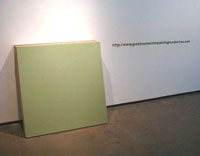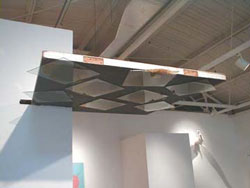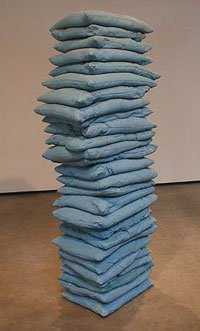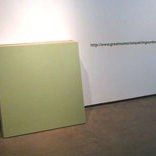Spring is in the air; DiverseWorks” Big as Texas show mixes new work from new artists and some peppy contributions from the usual suspects. Refreshing. Despite the inevitable peaks and valleys of a big group show, the energy at the opening was high, and gave me a welcome sense that there is some life left in the Texas contemporary art world.
It’s the best showcase of new work I’ve seen in a while, and shows admirable curatorial perseverance: Sara Kellner, Diane Barber and Paul Arensmeyer, the co-curators, turned over some new rocks in their Texas art hunt, going as far as Marfa to do it. Here are my picks; for the sake of argument, I’ll put them in order, best first, so you can disagree with greater precision:
Ludwig Schwarz‘s Great Moments in Painting Number Two is a viciously funny comparison of the real world and its virtual, on-line cyber equivalent. Six pastel canvasses are stacked against the wall; we can only see the one on top. Standard vinyl wall text gives the URL for the piece, the website for which consists solely of a photograph of the six paintings spread out so we can see them. Schwarz, in a razor sharp stroke not only admits, but exploits what we all suspected: everything’s more interesting if it’s virtual.
Christopher French’s Please More/Please No More is sexy. A pair of TVs shows the heads and nude shoulders of a man and a woman who stare impassively as sooty fingerprints apply themselves all over their faces against a background of heavy breathing. Knowing that the couple in the videos are the artist and his partner gives the piece an uncomfortably personal slant; we’re all used to provocative imagery, but rarely is it someone we know, and even more rarely is it a portrayal of a real relationship. French’s sexual portrait of two real-life, middle-aged people is almost unique. This PG-13 piece isn’t explicit or shocking, just suggestive; what makes it provocative is its sincerity. Also, the custom stand neatly transforms two television monitors into a credible sculpture, an elegant solution to the video-in-a-gallery problem.
Randy Wallace‘s Shingle is a giant playing card casually stuck into the gallery wall. Plates of window glass adhere to the underside on smears of viscous yellow grease. The piece has a vivid tactile unpleasantness like fingernails on a blackboard. Its muscular disregard for niceties gives the piece a grotesque joie de vivre.
Meg Langhorne‘s Blue Princess, an unsteady column of concrete pillows, has a figurative dynamism that takes it beyond mere formal translation. The hardened cushions retain a flabby, pliable pose, further softened by a powder blue tint.
Chuck Ramirez digital trash bag photos invite voyeurism — we peek at half-hidden discards through filmy white plastic, making instant personality profiles of the discarders. Fitness and Vegan are best, simulating real trash, while Black Bag is too straightforwardly S/M, as well as being opaque, to hold as much interest.
Amazing trompe l’oeil technique piles a second layer of bizarre fetishism onto Kirk Hayes” creepy, psychologically charged images. Always a little askew, Hayes faux collages place abject characters into odd, uncomfortable predicaments. Of his three works, Mouse-o-Tear is the most disturbing; an awkward figure bends to put its feet and hands into a tiny mouse hole in a pathetic attempt at hiding.
Justin Kidd‘s Control Room uses funky playpen technology to create a 1950’s computer center. The best part is the mess of trailing cords, each color coded with sloppy vinyl tape in a clunky parody of high technology.
Scott Burns” narrative tableaux place tiny devils, snowmen, ghosts and robots into rocky HO-scale foam landscapes; their infernal activities occasionally resonate with unsettling subconscious associations. Burns” rocky snowscapes are almost too well made; though they skillfully stage-manage the narrative action, interesting miniature details distract from the mini-psychodrama at the center of each piece.
Michael Roch‘s mythic plaster animals have expressive gestures.
Hilary Harnischfeger’s resin and glitter wall reliefs have a nice deco overkill.
I like shows without themes. Curators Kellner, Barber and Arensmeyer have reached a dip net into the Texas art aquarium and caught some keepers. Congrats, everyone!
All images courtesy the artists and DiverseWorks.
Bill Davenport is an artist and writer and was one of the first contributors to Glasstire.







